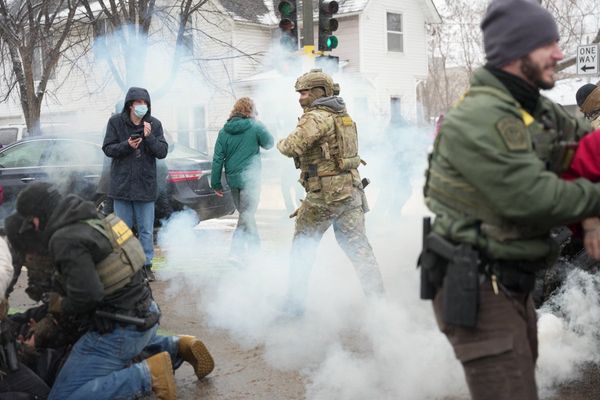
His work with people on the streets in 60s Britain dragged the country’s approach to tackling homelessness out of the Victorian era.
Anton Wallich-Clifford was an ex-probation officer whose work with the down-and-outs who regularly appeared before Bow Street magistrates court convinced him a top-down, paternalist approach to tackling homelessness was doomed to fail. Instead, he believed there was a need for charities to meet homeless people on their level and earn their trust, a revolutionary approach at the time but one now widely employed.
A raft of homelessness charities and Cathy Come Home, the shocking TV drama that provoked a public outcry over the treatment of homeless people, were inspired by Wallich-Clifford’s work co-founding the Simon Community, a network of centres that mushroomed across the UK and Ireland in the 60s and 70s, many of which continue to this day under different names. And yet today few people know of Wallich-Clifford who was born 100 years ago this Thursday and died in 1978 aged 55. Bereft even of his own Wikipedia entry, his impact remains largely unrecognised.
“There is no doubt that Anton has gone unrecognised as one of the great agents of change in UK society,” said Chris Hunton, chair of the Simon Community. “The work that he did changed the perception of the homeless and shone a light on the causes of homelessness.”

Now, however, a campaign is under way to earn him belated recognition. His supporters, who include his ex-wife, Marie-Therese Gibson-Watt, want Wallich-Clifford commemorated with a blue plaque at the site of the Simon Community’s original premises in Kentish Town, north-west London, where homeless residents still perform street outreach in line with the charity’s original communal ethos.
“We want it to recognise the profound change that Anton made in society,” Gibson-Watt explained.
“Before Anton, most of the organisations that existed to tackle homelessness were a legacy of the philanthropic Victorian era. Every big city had hostels for hundreds and hundreds of people, mainly men. Plus, there were still remnants of the workhouse system, although they were called government reception centres by then.
“Almost everything was top-down. Even in the Salvation Army hostels, you had to pray, and you had to pay for your knife and fork. You went up to bed in numbers.”
Wallich-Clifford was critical of this approach and believed it failed those scarred by mental health issues, including the war veterans he encountered suffering from PTSD.
“People believe that you can stop homelessness,” Gibson-Watt said. “Anton appreciated that there are things that happen in people’s lives that can make it difficult for them to function, like complex trauma.”
This is at odds with those who believe a complete end to homelessness is possible, a view recently promoted by the Prince of Wales.

“Any prominent person who’s willing to bring social problems to the attention of the public, you have to welcome that,” Gibson-Watt said. “But there will always be people who don’t understand other people, they get jobs, fall out of jobs, they don’t understand themselves, they misunderstand other people and that becomes chronic for them. And they end up just falling out of society because they can’t handle it.”
To meet these people’s needs, the Simon Community trained thousands of volunteers who lived in houses with homeless people, cooking and sharing chores, a therapeutic model that built trust and brought structure to chaotic lives – including those with addictions.
“Anton believed that there was no point in saying to somebody, ‘We’ll take you in when you get sober, or we’ll take you in when you come off drugs’,” Gibson-Watt said. “He would blend in and he would, if the meths bottle was being passed around, at least put it to his lips.”
Arriving back from their honeymoon in 1967, the couple opened a house for addicts in east London, a radical departure from how drug users had previously been treated but a model that was later widely emulated.
“There were people being prescribed British pharmaceutical-grade heroin, cocaine and liquid methadone,” Gibson-Watt said. “It was a sort of upside-down life there because they mainly slept during the day and were active at night. This approach was very influential and cutting edge at the time.”
A charismatic speaker who toured the country promoting the Simon Community’s ideals, Wallich-Clifford understood the power of publicity. Dad’s Army actor John Le Mesurier was a patron and, in 1978, a BBC appeal for the charity raised £34,000 – £250,000 in today’s money. Photographs of homeless people in London by the renowned photojournalist Sir Don McCullin feature in Wallich-Clifford’s plaintive memoir, No Fixed Abode.
His influence was pervasive. One supporter inspired by his work with meth addicts left to form St Mungo’s, a leading homelessness charity. An alliance with a Soho church was the genesis of Centrepoint, the UK’s leading youth homelessness charity. A story the writer Jeremy Sandford produced for a newsletter founded by Wallich-Clifford went on to become Cathy Come Home, the Ken Loach-directed BBC drama whose shocking depiction of a family’s descent into homelessness provoked a national furore, triggered changes to the law, and led to the creation of the charity, Crisis.
“Anton was a visionary who drove the visibility of the homeless and awareness of the causes of homelessness,” Hunton said. “He emphasised that society shouldn’t look away and the Simon Community and the other charities he helped start are his legacy.”
This Thursday, a picnic will be held in Wallich-Clifford’s honour at Lincoln’s Inn Fields, attended by some of those he inspired.
Although he did not press it on others, Wallich-Clifford’s own inspiration was based in part on his strong religious conviction. “He was driven by the suffering of Christ,” Gibson-Watt said. “He used to say you could see the face of Christ in every person that you saw on the street.”
• This article was amended on 31 July 2023. Anton Wallich-Clifford was 55 when he died in 1978, not 58 as an earlier version said.







